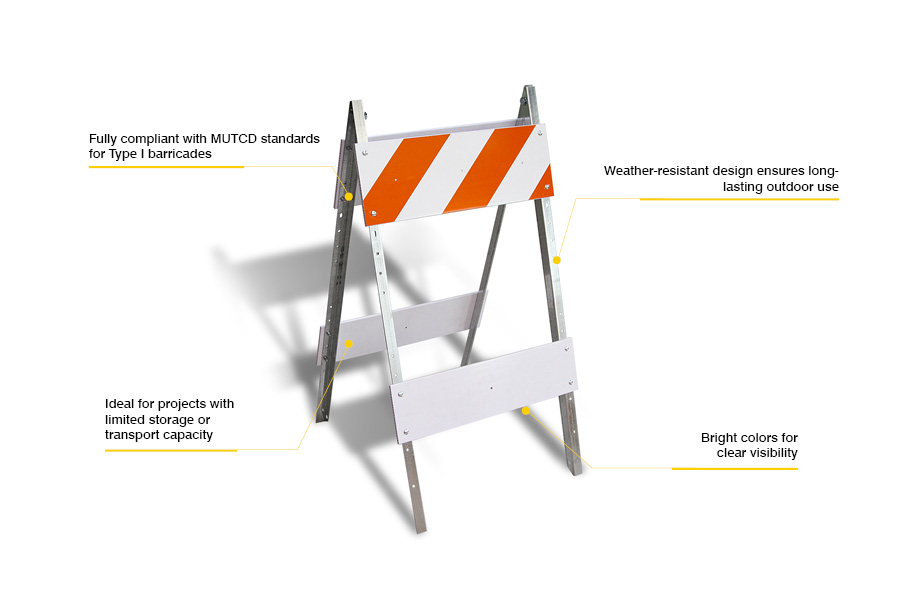
Die Absperrung vom Typ I dient der Lenkung und Kontrolle des Fußgänger- und Fahrzeugverkehrs in temporären Arbeitszonen oder Veranstaltungsräumen. Sein einzelnes reflektierendes Panel sorgt für klare Orientierung, Gewährleistung von Sicht und Sicherheit unter verschiedenen Bedingungen. Hergestellt aus langlebigem, Wetterresistente Materialien, Es hält den Elementen im Freien stand und behält gleichzeitig seine Funktionalität.
Das faltbare Design der Barrikade ermöglicht einen schnellen Einsatz und eine einfache Lagerung, Dies macht es ideal für Situationen, die eine schnelle Einrichtung erfordern. Es ist auch mit Sandsäcken oder Gewichten kompatibel, um die Stabilität bei Wind oder auf unebenem Untergrund zu verbessern. Diese Merkmale machen die Barrikade vom Typ I zu einer kostengünstigen und praktischen Lösung für die vorübergehende Verkehrskontrolle.
*Wir respektieren Ihre Vertraulichkeit und alle Informationen sind geschützt.
| Plattenmaterial | Auf Bauchmuskeln |
|---|---|
| Rahmenmaterial | Verzinkter Stahl |
| Reflektierender Film | EG/HIP/DG/Anpassbar |
Klappen Sie die Barrikade auf und platzieren Sie sie an der gewünschten Stelle.
Stellen Sie für maximale Sichtbarkeit sicher, dass die reflektierende Platte dem Gegenverkehr zugewandt ist.
Fügen Sie Sandsäcke oder Gewichte hinzu, wenn die Barrikade in Gebieten mit starkem Wind oder in unebenem Gelände verwendet wird.
Überprüfen Sie die Barrikade regelmäßig auf Beschädigungen oder Abnutzung, vor allem die reflektierende Platte.
Reinigen Sie die reflektierende Oberfläche, um die Sichtbarkeit zu gewährleisten.

Ein PE -Verkehrskegel, oder Polyethylenkegel, ist eine Art Verkehrskegel aus strapazierbarer Kunststoff. Diese plastischen Sicherheitszapfen sind leicht und dennoch belastbar, sie ideal für den Einsatz in verschiedenen Umgebungen wie Baustellen und Straßensicherheitsanwendungen.
Die Basis der Opt -Signs -PE -Verkehrskegel besteht aus Gummi, Dies bietet Stabilität und verhindert ein Trinkgeld. Dieses haltbare Material sorgt dafür, dass die Kegelbasis die Straße effektiv greift, Verbesserung der Sicherheit in verschiedenen Umgebungen.
Die Basis eines Kegels, vor allem in Verkehrskegeln, ist in der Regel breit und schwer ausgelegt, oft aus Materialien wie Gummi oder Kunststoff hergestellt. Dies hilft, zu verhindern, dass die Kegel auf der Straße leicht umgeschlagen werden, sicherstellen, dass sie im Verkehrsmanagement effektiv bleiben.
Ein Pylon ist im Allgemeinen größer und robuster, häufig für dauerhafte oder semi-permanente Installationen verwendet, Während ein Verkehrskegel tragbarer ist und für die temporäre Verkehrskontrolle verwendet wird. Farbige Verkehrskegel wie Orange oder Blau sind häufig für Führung oder Warntreiber in verschiedenen Situationen üblich.
Ja, Polyethylen (Pe) ist ein sehr vielseitiger Kunststoff, der für seine Haltbarkeit bekannt ist, Flexibilität, und Widerstand gegen Feuchtigkeit und Chemikalien. Dies macht es zu einer hervorragenden Wahl für Produkte wie Plastikverkehrskegel, die eine Haltbarkeit für die Verwendung im Freien und eine lang anhaltende Leistung erfordern.
